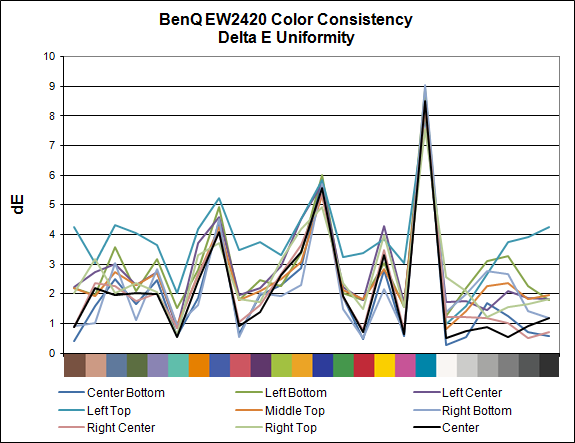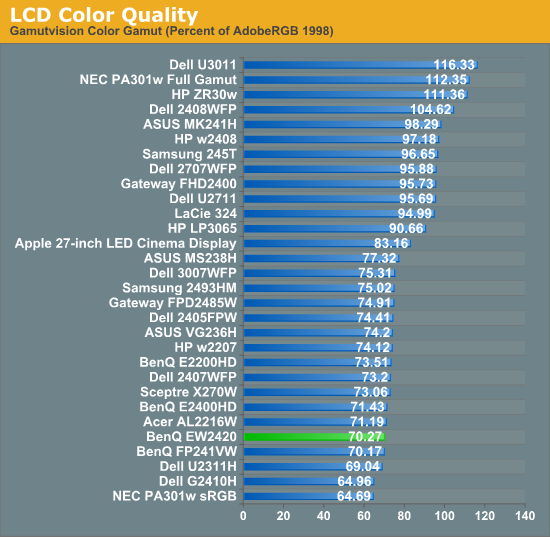BenQ EW2420 Monitor Review
by Chris Heinonen on October 13, 2011 12:00 AM ESTColor Uniformity
The overall color quality of the BenQ was just acceptable with a dE of slightly over 2, and that isn’t limited to the center. Color quality is best at the center and middle-bottom of the screen, with the error level getting higher at the top and corners of the screen.



This is a pattern that we will see repeated when we get to the brightness uniformity charts as well. Most likely this is caused by unevenness in the LED backlighting across the screen, which influences the color quality as a result. With a dE that doesn’t fall below 2 anywhere on the screen, the BenQ isn’t a display that can be recommended for serious print work, but for day-to-day use it should be good enough. As with most displays the highest dE errors occur in colors that are a majority blue, and these errors are less visible to the eye than if the colors were mostly red or green. Grayscale tracking was very good overall, and that’s the most important element of image as far as human vision is concerned.
Color Gamut


The BenQ EW2420 has LED backlighting but still only covers the standard sRGB colorspace and not the AdobeRGB space. We see in the gamut chart that it covers around 70% of the AdobeRGB space, which is average. This also contributes to the higher dE values as some of the color samples used in that test fall outside of the sRGB gamut.










47 Comments
View All Comments
dcollins - Thursday, October 13, 2011 - link
That makes absolutely no sense. How could less resolution in the same size possibly be worse for working? You get more vertical and horizontal space.mi1stormilst - Thursday, October 13, 2011 - link
It seems to me that it is really hard to make choices about which monitors are the best for gaming and photo editing below $400.00. What I want is a good IPS or VA based monitor that is great on color reproduction, but fast enough to game with and then pair it with two decent TN based panels (sides) for some fun eyefinity stuff. I need to replay Deus Ex in triple portrait mode soon or I am going to go crazy ;-PLordSojar - Thursday, October 13, 2011 - link
The choice is actually very easy....The ASUS PA246Q is by far the best gaming and photo editing monitor available, period. Turn off trace completely for gaming and you've got one wicked gaming monitor... and it's 98% Adobe RBG space. I own one, and will NEVER go back to any TN garbage nor will I ever "upgrade" to a 16:9 monitor that has an IPS panel. Blasphemy!
Death666Angel - Thursday, October 13, 2011 - link
That monitor should be a few bucks over $400 though.mobutu - Thursday, October 13, 2011 - link
People really should educate themselves and never ever buy crappy TN.In notebooks/laptops/nettops/ultrabooks too. Crappy TN with crappy Glossy ... yuck!
dcollins - Thursday, October 13, 2011 - link
I don't do print or serious color work, don't play first person shooters, and only use my monitor sitting in the same spot at my desk.I can get a 23" Acer TN panel monitor for $150 that serves my needs. Why waste $200 on features I do not need?
cactusdog - Thursday, October 13, 2011 - link
People should educate themselves about changes in the computer industry and changes in technology, instead of regurgitating old out of date information from 2004.120Hz is the new must have for gamers and will be standard kit within the next year or so. Only people who never tried a 120Hz say they will only use 60Hz IPS.
I know guys selling their U2711's for SA950's thats how good they are.
Death666Angel - Thursday, October 13, 2011 - link
"The BenQ EW2420 has LED backlighting but still only covers the standard sRGB colorspace"That reads a bit strange (though not wrong). As far as I know, normal LED backlighting has inferior color range than CCFL (which is used in most wide-gamut and professional monitors). The only way for LED to offer competitive color range is to use RGB LEDs. Your statement above makes it sound as though LED generally has superior color range, but just this one monitor doesn't make use of it. :-) Or am I wrong?
Otherwise, I don't see the appeal in 1080p @ 24". But good review!
cheinonen - Thursday, October 13, 2011 - link
Correct. I know many people that see LED backlighting and think "Oh, it has a wider color spectrum then!" since many of the initial LED displays did use RGB LEDs to have that larger spectrum, or at least promoted it as a major feature of being LED based. I just wanted to be clear that it wasn't the case here. It's always a fine line between assuming too much or too little when you try to figure out how detailed to be on every point.dingetje - Thursday, October 13, 2011 - link
no thanks BENQ....16:9 panels are crap